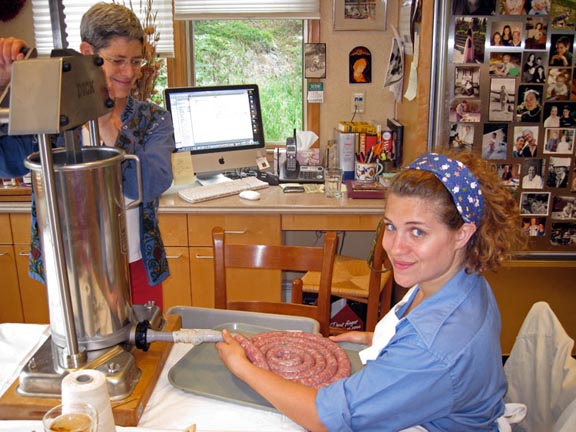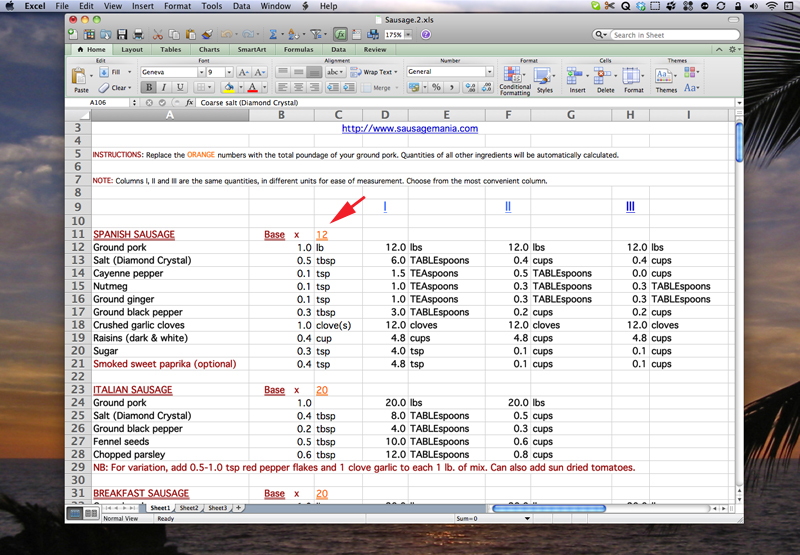home | meat grinders | sausage stuffers | sausage casings | e-mail SausageMania | NEW! Sausage Photo Tutorial | sausageMania recipes |more SausageMania recipes | motorize a grinder | tips | links | kippermania | loxmania | NEW! PestoMania | NEW! Even MORE SausageMania Recipes! | NEW! Lox Making Photo Tutorial | NEW! CaviarMania | NEW! Porcini Sausage!

How to Make Delicious, Succulent Sausage at Home — All You Need to Know for Mouth-Watering Success!
A Sausage Stuffing Session in Full Swing. YOU can do this, too, with a little practice!
SausageMania is proud to present its brand-new Sausage Making Photo Tutorial, with new text and photos to make certain you turn out perfect home made sausages from the Get-Go!
Nothing in these photos is staged — these are not slick "food studio" shots… These photos are of several real, down-to-earth, day-long sausage-making sessions done in our own kichen, not in some fancified food prep studio such as you see on TV.
You needn't spend a fortune on equipment: you can start off with small, manual meat grinder or a food processor, a basic hand funnel (essentially unchanged since ancient Roman times) for under $10.00, or a 3-lb "pump handle" push stuffer for under $50.00. The sausages you make with the least expensive equipment will be every bit as "professional" and delicious as the sausages you make with the most expensive equipment… You just won't be able to churn out 100 lbs in a single, day-long session without the fancier gear.
You'll need some supplies and some tools before you embark on your Sausage Adventure. First off, you need some pork. That's right — pork — not beef, lamb, venison, chicken, turkey or wallaby. Pork is the only meat worth using for sausage. Unfortunately, our obesity-conscious culture has made fat a dirty word, so today's pork is much leaner than the pork of yesteryear. To be decent, sausage needs at least 20% fat: with too little fat, sauage will not slice, but will crumble like dry breadcrumbs and taste like cotton. So avoid lean (but pricey) cuts, like loin, and go for the cheaper cuts. Pork shoulder, a.k.a. Boston butt, Boston blade or simply "pork butt," is one of the fattier cuts. We buy it in 70-80 lb. cartons at Costco, where the carton is sold at a slightly discounted price per pound.
Make sure to get boneless pork shoulders. The bone-in pork shoulders cost less, but then you have to bone them out, which is time consuming, plus you might just lose a fingertip in the process.
Next you need casings, not readily available either at the supermarket or specialty butcher. Quality, natural, non-artificial casings are the key to sausage making success: buy crappy casings and you'll spend all day dealing with ruptures. Avoid collagen or fibrous casings and look for genuine hog or sheep casings. Casings come hanked (like a big skein of yarn) or tubed, and are either wet-packed or dry-packed in salt.
Hanked casings are a real pain — they get knotted up with one another and are hard to run up onto the stuffing horn. So get dry-packed tubed casings, which are 10 times easier to use: soak them in warm water for at least 30 mintues, it's easy to find the end, and then flush them thoroughly with warm water: that way, you can run them up onto the sutuffing tube with no hang-ups. The best source, hands down, is Syracuse Casing Company. They sell U.S.-made hog casings in several diameters, and sell prime Australian or New Zealand sheep casings. They ship promptly and inexpensively, by Priority Mail.
Now for the spices: do NOT use those ancient spices that have been hanging around in the back of your spice cabinet since before Y2K. Get fresh spices, either from the bulk spice section at your supermarket, a local spice and tea store, or on-line. One of the best, most comprehensive spice sources is Spicebarn.com, who also ship by Priority Mail, usually in a flat-rate box to save you money.



































